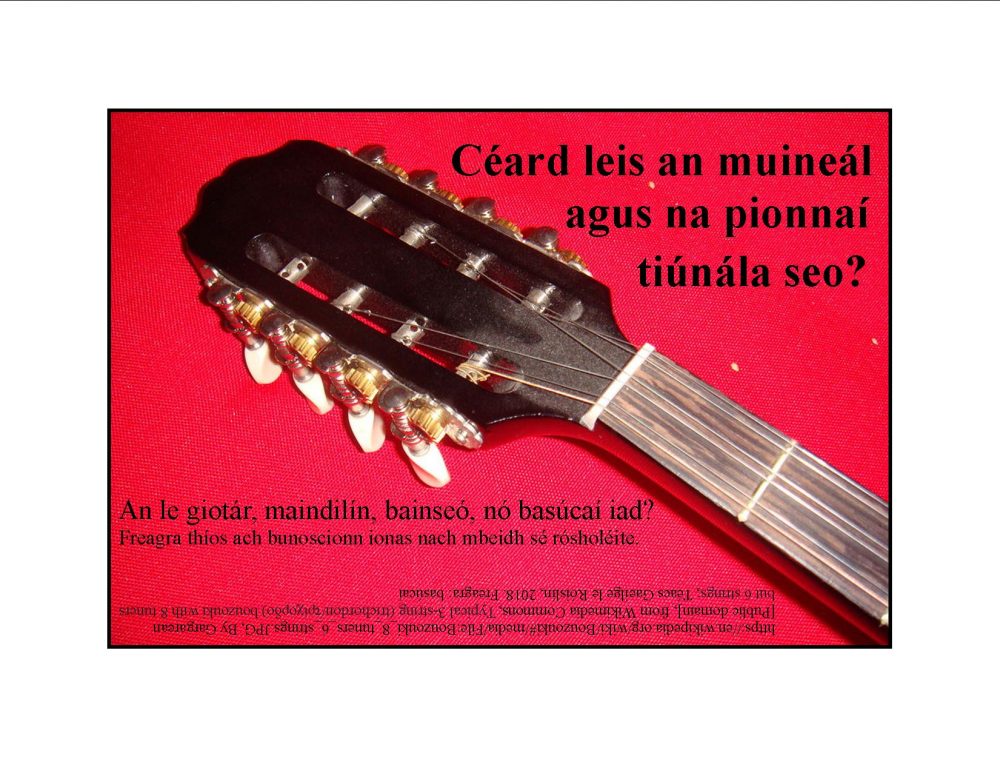Ag Seinm Ceol Gaelach? Irish Words for Musical Instruments and How to Use Them in Phrases (Pt./Cuid 2) Posted by róislín on Mar 25, 2018 in Irish Language
(le Róislín)
Bhuel, last time we looked at various musical instruments typically used in Irish music, and recognized a few non-traditional instruments (uirlisí neamhthraidisiúnta) in passing as well (an didiridiú, an hang). Today we’ll continue with a few more of the traditional ones.First, let’s review from the previous post, and here we’ll just do a mixture of singular and plural forms after the verb “playing” (ag seinm), not both forms like we did before. The basic word is in parentheses — we’re mostly concerned with changes at the beginning or ending of the word here. Freagraí thíos (Grúpa A). The number of blanks indicates the number of letters in the answer.
- ag seinm na _ _ _ _ _ _ _ _ _ _ _ _ _ (fliúit, flute)
- ag seinm na _ _ _ _ _ _ _ _ _ _ _ (fidil, fiddle)
- ag seinm na _ _ _ _ _ _ _ _ stáin (feadóg stáin, tin whistle, and let’s make this one singular — it’s unusual but the singular and plural forms would have the same number of letters for this one, so you can’t tell which to fill in just from the number of blanks)
- ag seinm an _ _ _ _ _ _ _ _ _ (bodhrán, bodhrán — there’s no English for it really, except describing it as a “hand-held drum” — but that could be many instruments from many cultures)
- ag seinm na _ _ _ _ _ _ _ (cláirseach, harp — and where did some of those letters go, you might ask, is this form of the word really shorter than the root form? The answer is yes, because certain sounds became silent and then the spelling reform in the 1950s eliminated them in the Litriú Caighdeánach)
So that’s our review, and now let’s continue with four more. I’m saving “an phíb uilleann” for another post, because it’s a little more complicated, phrase-wise, than some of the other “uirlisí ceoil.”
- bouzouki: basúcaí, an basúcaí, na basúca_ _ _ _, ag seinm an b_asúcaí, ag seinm na _basúca____
- guitar: giotár, an giotár, na giotá_r, ag seinm an g_iotá_r, ag seinm na _giotár
- mandolin: maindilín, an maindilín, na maindilín_, ag seinm an m_aindilín, ag seinm na maindilín_
- banjo: bainseó, an bainseó, na bainseó_ _ _, ag seinm an b_ainseó, ag seinm na _bainseó_ _ _.
So, sin ceithre cinn eile agus a bhfoirmeacha éagsúla. Hope you found the practice fun and helpful, and that you get to listen to some of this music, not just talk about it and fit the nominatives and genitives, singulars and plurals, and lenitions and eclipses into their respective places for grammatical accuracy.
And don’t forget, if you’re particularly interested in this topic, we previously did a 4-part series of music instruments from around the word (alpchorn go xileafón), the naisc for which are thíos. I was trying to go completely from A to Z in Irish for the list, but really couldn’t find any instruments whose Irish names started with “y” or “z.” So it was just “A go X.’ But it’s still fun to look over, especially if you’re interested in music from an international perspective. And if anyone can come up with an Irish musical instrument name starting with “y” or “z”, please do let me know, and I’ll add an appendix (an “aguisín,: not an “aipindic“!) or a footnote (fonóta) to that series.
Slán go dtí an chéad uair eile – Róislín
Freagraí (Grúpa A)
- ag seinm na bhfliúiteanna
- ag seinm na bhfidleacha.
- ag seinm na feadóige stáin
- ag seinm an bhodhráin
- ag seinm na cláirsí
Freagraí (Grúpa B):
- bouzouki: basúcaí, an basúcaí, na basúcaithe, ag seinm an bhasúcaí, ag seinm na mbasúcaithe. Of course, this is originally Gréagach, not Gaelach, but it has been a fixture in Irish music since the 1960s, thanks to the likes of Johnny Moynihan, Andy Irvine, Alec Finn, Dónal Lunny, et al.
- guitar: giotár, an giotár, na giotáir, ag seinm an ghiotáir, ag seinm na ngiotár
- mandolin: maindilín, an maindilín, na maindilíní, ag seinm an mhaindilín, ag seinm na maindilíní (no initial change because the letter “m” doesn’t take eclipsis, which is one of the initial sound changes in Irish)
- banjo: bainseó, an bainseó, na bainseónna, ag seinm an bhainseó, ag seinm na mbainseónna. Also sometimes spelled as “bainseo,” without the long mark (ó), but still pronounced “long” (like “ró” or “só“). Slightly older sources seem to not write the “fada;” newer sources tend to include it, but so far that’s just a general observation, not a predictive rule for spelling this word. And it doesn’t really affect what we’re doing here, anyway.
Freagra C: It was probably clear already if you read the caption carefully or if you read the “téacs bunoscionn” in the graphic, but just in case, it’s “basúcaí.”
Naisc: Iarmhíreanna faoi uirlisí ceoil (ó alpchorn go xileafón):
Ag seinm uirlisí ceoil, ó alpchorn go xileafón (Alpenhorn to Xylophone in Irish, pt. 1)Posted by róislín on Mar 19, 2015 in Irish Language
Ag seinm uirlisí ceoil, ó alpchorn go xileafón (Alpenhorn to Xylophone in Irish, Pt.2): ideafón go hócairínPosted by róislín on Mar 21, 2015 in Irish Language
Ag seinm uirlisí ceoil, ó alpchorn go xileafón (Alpenhorn to Xylophone in Irish): Pt. 3: Pianó go siotar AGUS siotárPosted by róislín on Mar 25, 2015
Ag seinm uirlisí ceoil, ó alpchorn go xileafón (Alpenhorn to Xylophone in Irish): Pt. 4: Triantán go xileafónPosted by róislín on Mar 29, 2015 in Irish Language

Build vocabulary, practice pronunciation, and more with Transparent Language Online. Available anytime, anywhere, on any device.





Leave a comment: